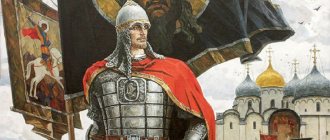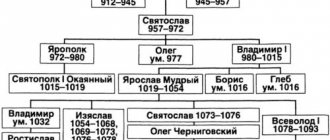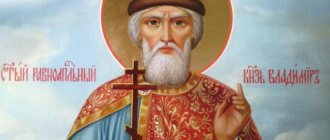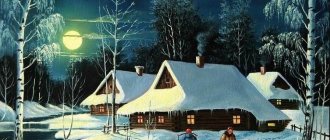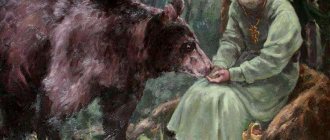from December 25 to January 6 - the Most Magical Days in Rus'
We found an interesting article about carols. We hasten to share. Yes, there are many opinions on how it was and how it really is. We invite you to familiarize yourself with one of the versions. FROM DECEMBER 25 TO JANUARY 6 - THE MOST MAGICAL DAYS IN RUSSIA From December 25 to January 6 in Rus', people celebrate the Great Veles Christmastide - twelve holy days, symbolizing the twelve months of the year (six light - the light half of the year, and the other six dark - the dark half of the year ), starting from the eve of Kolyada (Kolyada itself is not included in the number of holy days) and until Turitsa (Vodokres). A magical time, when the light of the new Sun is still too weak to disperse the darkness (as it was in the days when Svarog was just forging the Earth’s Firmament), and the Gates connecting Reality and Nav are wide open. This is the time to commemorate our ancestors and grandfathers, caroling, ritual outrages, various fortune-telling, wide public festivities and youth gatherings. At this time, “feeding” of Frost (Grandfather Frost - the Winter Face of Veles, the Master of Navi, the Lord of the Dead) is performed with funeral grass - kutya (porridge prepared from wheat grains soaked in water with the addition of dry fruits and honey) - also associated with the veneration of ancestors . Costumed in the guise of people from Navi (in the form of Navi Grandfathers) and in the guise of animals, they went around houses, sang wishes for good things for the coming year and received for this gifts in the form of all kinds of treats from the festive table, as well as kutya (for it was believed that in the guise, caroling the souls of their ancestors come to people living in Yavi). Christmastide in Rus' was divided into two parts: Holy Evenings, which lasted from the eve of Kolyada until the Generous Evening - from December 25 to December 31, and Terrible Evenings, starting from the Day of Morok and lasting until Turitsa - from January 1 to January 6. Yuletide evenings (especially Scary ones) were considered by the people to be the time when evil spirits ran amok. With the onset of the shortest days and longest nights of the year, according to the ideas of our ancestors, it was believed that winter had defeated the sun, that it had grown old and was about to fade away. So it really was, for a new sun was born - the child Khors. Various magical rites and ceremonies were performed that were designed to help the sun to be reborn. In addition, it was believed that these rituals would influence the powerful forces of nature and bring a new bountiful harvest next year. Thus, in the minds of our ancestors, the essence of winter rituals and songs was to ensure a future good harvest, offspring of livestock, and a happy family life. The time of winter Christmastide in the life of the people was full of caroling, mumming, games and horseback riding and sledding, predictions, omens, fortune-telling, songs and dances. Caroling is going from house to house with short carol songs glorifying Kolyada, the owners of the house, with congratulations on the New Year (New Year), with wishes of happiness, wealth, harmony and goodness. Each carol should consist of several parts: 1. A message that carolers are coming; 2. Glorification of the owners of the house; 3. Please give gifts to the carolers; 4. Congratulations on Kolyada and the New Year. Carolers were presented with specially baked “roes”, “cows”, pies, fruits and money. To collect gifts, among the carolers there were mehanoshi, that is, people who carried a deep bag of gifts. Sometimes greedy owners drove away uninvited guests. Then the carolers sang special corilding carols or “curse carols” for them, in which the owners were promised various threats: “let’s take the cow by the horns,” “into the house of devils, and into the garden of worms.” Carolers always carried with them one particularly important attribute - the “Sun” with rays on a pole, as a symbol of the birth of a new Sun. Carolers also used nativity scenes - special two-tiered boxes, inside of which scenes dedicated to the celebration of Kolyada were acted out using wooden or rag dolls. On Christmastide it was customary to dress up, that is, to put on outlandish, unusual costumes and masks (masks). First of all, these were costumes and masks of animals: bear, bull, horse, goose, goat, crane, fox, as well as fairy-tale and mythological creatures: kikimora, goblin, brownie, merman. In the same way, people dressed up as an old man and an old woman (a girl dressed up as an old man, and a guy as an old woman), a soldier, a doctor, a master and a servant. Each costume and each mask were traditional, that is, their meaning and meaning were passed down from generation to generation. Each mask was associated with certain actions and texts - sayings. It is believed that our ancestors turned to mummery because they were afraid of evil spirits, which became more active as the dark time of the day increased. If you dress up and hide yourself under a guise, then the evil spirits will not recognize and will not cause harm. Sledding down the mountain also had a magical meaning; it was believed that the one who went down the mountain the farthest would have long-fiber flax stalks in the new year and the harvest would be good.
Christmastide 2021
Estimated reading time: less than a minute.
Christmastide is a joyful, festive day between Christmas and Epiphany. Ancient Christians glorified the Incarnation and Epiphany together, and only later these holidays were separated in most Christian churches. Now Christmastide reminds us of their calendar unification. In 2021, this is, as always, ten days from January 8 to January 17.
For forty days, believers prepared to meet the Infant Christ by fasting. And as a reward for abstinence during the Yuletide period, fasting is canceled altogether. This is one of five continuous periods of the year when even on Wednesday and Friday (days of strict abstinence throughout the year) meat and dairy foods are allowed. But the absence of restrictions does not mean that everything is permitted. Both feasts and amusements should not be excessive, and entertainment should not be harmful and dangerous to the soul.
Traditionally, folk festivities are held on Christmastide, but in 2021, when restrictions are introduced around the world due to the pandemic, Christmas is celebrated on a smaller scale. The cancellation of festivals and other public events cannot affect the inner feeling of the holiday. We rejoice at an incomprehensible miracle that happened two thousand years ago and changed the course of history. The Almighty Lord appeared into the world as a defenseless Baby, took upon Himself the image of a man in order to go through earthly sorrows, suffering and death, and then with His Resurrection pave the way to the Kingdom of Heaven, which anyone who believes can follow. And the work of saving humanity began in a small cave where the Infant of God was destined to be born.
It is important for Christians that Christmas joy touches everyone's heart. Therefore, it has long been customary to support those who are in a difficult situation, who are sick, who are suffering, on holy days. Even a small gift, a modest donation, a kind word can help a person in the darkness of circumstances to see the light of the Star of Bethlehem. And, perhaps, more important than feasts and entertainment these days is to share warmth and hope with those who really need it.
After Christmas, the celebration of which ends on January 13, there is another date associated with events from the Savior’s childhood. On January 14, the Orthodox Church remembers how the holy parents circumcised the Child on the eighth day and gave Him a name. This day is not one of the biggest Christian holidays, but has its own special meaning. The Jewish rite of circumcision can be called a prototype of Christian baptism. The holiday of Baptism, which Jesus received before His preaching and during which God appeared in three Persons, is celebrated by the Orthodox Church immediately after Christmastide.
Thus, the Christmastide period is framed by two holidays, each of which symbolizes the beginning: Christmas - the earthly journey of the Lord, and Epiphany - His Way of the Cross. Therefore, these Holy days should be filled not only with fun, but also with a deep understanding of what we remember and rejoice about, and gratitude to the God who loves us.


